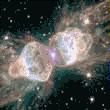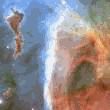|
|
|
Keith
Noll,
Principal Investigator
|
Sometimes
the language of science obscures the true measure of what scientists
study. But asteroids streaming through space, nebulas ablaze in
orange and blue, and star clouds studded with brilliant beacons
speak volumes about the wonders of the universe. That’s why,
once a month,
the
Heritage
Project
unveils a new masterwork of technical and aesthetic
ingenuity, all captured in a single image.
"Our
telescope brings the wild and exotic things in outer space to
the front covers of newspapers and magazines," says Heritage
image processor Lisa Frattare. "It shows them that there
are these really cool things, like the Planetary Nebula (right)
that are doing their thing out in space." And a dazzling
astral vista, Heritage scientists believe, will surely arouse
people’s curiosity about the science behind the phenomena.

|
|
The
Ant Nebula (Planetary Nebula Mz3), 3,000 light-years from
earth.
|
Thanks to
the state-of-the-art Hubble Space Telescope, those images are
ever more stunning--and scientifically accurate. Orbiting beyond
the distorting effects of earth’s atmosphere, Hubble produces
images of unprecedented quality, resolution, and detail, far exceeding
the capabilities of ground-based scopes. "Before you could
tell that something was a circle, but it

|
|
The
"Polar Ring" galaxy, chosen by 8,000 Internet
voters.
OTHER WINNERS
|
was
a fuzzy circle," says Frattare. "Now, with the resolution
of HST, you can get in there and say, that’s the start of
a solar system, or that’s a star with a jet exploding off
of it."
To decide
which images to showcase, scientists scour the Hubble archive
for the perfect blend of arresting beauty and scientific interest.
But the archive doesn’t always satisfy the search. Since
visually appealing targets don’t necessarily make compelling
research subjects, Heritage scientists sometimes reserve observing
time on Hubble to gather their own data. And they ask for public
input. So far, Internet voters have picked three Heritage targets.
Once a target
is chosen, Hubble’s instruments collect data--stored in long
strings of numbers--that breaks down the radiant light into discrete
colors to reveal the target’s temperature, motion, composition,
and age. Translating those numbers into a visual snapshot of the
scientific phenomenon requires the talents of many scientists
with different areas of expertise. Star formation experts might
lend a hand to create an image of a nebula, or "star nursery,"
while experts in galactic structures might help determine the
appearance and nature of a galaxy.

|
|
The
Spirograph Nebula (Planetary Nebula IC 418), 2,000 light-years
from earth.
|
Heritage
scientists generally assign colors based on what the highly sensitive
telescope "sees" rather than on what the human eye could
see if it were out in space. We can’t detect ultraviolet
radiation or extremely dim light, but the telescope can. These
invisible parameters can convey important scientific details that
escape notice in the visible spectrum. Reflecting the telescope’s
keener vision, Heritage images capture subtle structural and light
effects that emphasize scientific phenomena.
The Heritage
Project has given astronomers an important tool for educating
the public, making the science of the stars more accessible. For
astronomer and Heritage creator Keith Noll, that’s the whole
point. "The project has always been more about beauty than
truth," Noll says. "Beauty has its own form of truth,
one that transcends barriers of language and education. It reaches
closer to our hearts than to our heads. As Walt Whitman said so
beautifully, sometimes it’s okay to leave the darkened lecture
hall and simply look up in silence at the stars."

|
|
The
Keyhole Nebula (NGC 3372), 8,000 light-years from earth.
|
|
![]()
![]()